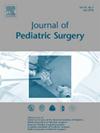中国 105 名肝外门静脉阻塞患儿接受雷克斯分流术的中长期疗效。
IF 2.4
2区 医学
Q1 PEDIATRICS
引用次数: 0
摘要
目的:我们的研究旨在分析大量肝外门静脉阻塞(EHPVO)患儿接受雷克斯分流术的中长期疗效:方法:对本中心在2014年10月至2021年6月期间接受雷克斯分流术的105名6个月至16岁肝外门静脉阻塞患儿的临床资料进行回顾性分析,随访时间超过2年:中位随访 41 个月(24-98 个月),雷克斯分流术的总通畅率为 91.43%(96/105)。105 位患者中有 87 位(82.86%)接受了传统雷克斯分流术和颈内静脉分流术,其余 18 位患者(17.14%)接受了改良雷克斯分流术和腹内静脉分流术。分流通畅的患者门静脉高压症状缓解,表现为门静脉压力降低、静脉曲张出血消失、胃食管静脉曲张缓解、脾大或脾功能亢进缓解。我们中心的雷克斯分流术血栓形成率为 8.57%(9/105),重复雷克斯分流术对治疗移植物血栓形成有效。14.26%(15/105)的患儿发生了吻合口狭窄,其中38.46%(5/13)的患儿成功接受了血管内介入治疗,门静脉高压症状得到缓解。经典雷克斯分流术的通畅率高于改良雷克斯分流术(97.70% 对 61.11%),而经典雷克斯分流术的血管并发症(包括吻合口狭窄和移植物血栓)发生率低于改良雷克斯分流术(11.49% 对 77.78%)。进一步比较发现,在未调整模型、最小调整模型和完全调整模型中,改良雷克斯分流术组的血管并发症风险远高于经典雷克斯分流术组(RR 为 6.77 至 7.07,均为 p 结论:改良雷克斯分流术是一种中长期的血管并发症治疗方法:雷克斯分流器能为 EHPVO 患儿带来中长期的益处。经典的雷克斯分流术加 IJV 旁路可提供最佳的通畅率和最少的血管并发症:研究类型:ⅲ:回顾性比较研究。本文章由计算机程序翻译,如有差异,请以英文原文为准。
Medium-to Long-term Outcomes of Rex Shunt in 105 Children With Extrahepatic Portal Vein Obstruction in China
Purpose
The aim of our study was to analyze the medium-to long-term outcomes of Rex shunts in a large series of children with extrahepatic portal vein obstruction (EHPVO).
Methods
The clinical data of 105 children aged between 6 months and 16 years with EHPVO who underwent Rex shunt between October 2014 and June 2021 at our center were retrospectively reviewed after more than 2 years of follow-up.
Results
The overall patency rate of the Rex shunt was 91.43% (96/105) during a median follow-up of 41 months (range, 24–98 months). Eighty-seven (82.86%) of the 105 patients underwent classical Rex shunt with internal jugular vein (IJV) bypass, and the remaining 18 patients (17.14%) underwent modified Rex shunt with intra-abdominal vein bypass. Patients with a patent shunt experienced portal hypertension resolution, which was characterized by a reduction in portal pressure, disappearance of variceal bleeding, relief of gastroesophageal varices, and relief of splenomegaly or hypersplenism. The rate of Rex shunt thrombosis in our center was 8.57% (9/105), and a repeat Rex shunt was effective for the treatment of graft thrombosis. Anastomotic stenosis occurred in 14.26% (15/105) of the children, 38.46% (5/13) of whom received successful endovascular intervention therapy and experienced remission of portal hypertension symptoms. The patency rate of the classical Rex shunt was higher than that of the modified Rex shunt (97.70% vs. 61.11%), whereas the rate of vascular complications, including anastomotic stenosis and graft thrombosis, of the classical Rex shunt was lower than that of the modified Rex shunt (11.49% vs. 77.78%). Further comparison revealed that the risk of vascular complications was substantially greater in the modified Rex shunt group than in the classical Rex shunt group in the nonadjusted model, minimally adjusted model, and fully adjusted model (RR ranged from 6.77 to 7.07, all p < 0.001).
Conclusions
The Rex shunt provides medium-to long-term benefits for children with EHPVO. The classical Rex shunt with IJV bypass provides the best patency rate and the fewest vascular complications.
Levels of Evidence
Ⅲ
Type of Study
Retrospective comparative study.
求助全文
通过发布文献求助,成功后即可免费获取论文全文。
去求助
来源期刊
CiteScore
1.10
自引率
12.50%
发文量
569
审稿时长
38 days
期刊介绍:
The journal presents original contributions as well as a complete international abstracts section and other special departments to provide the most current source of information and references in pediatric surgery. The journal is based on the need to improve the surgical care of infants and children, not only through advances in physiology, pathology and surgical techniques, but also by attention to the unique emotional and physical needs of the young patient.

 求助内容:
求助内容: 应助结果提醒方式:
应助结果提醒方式:


